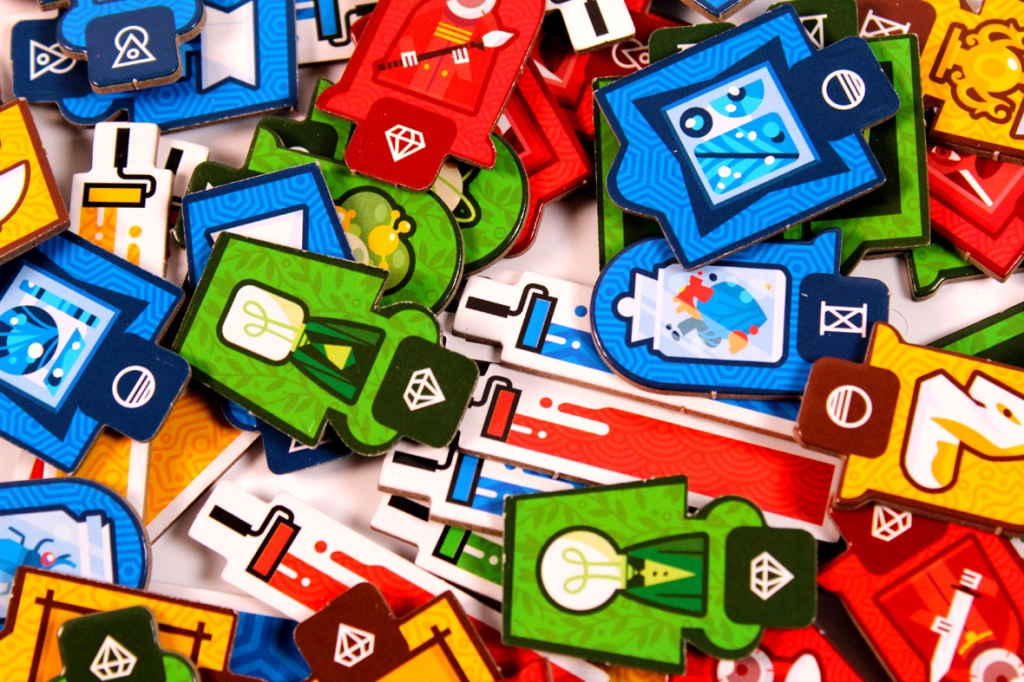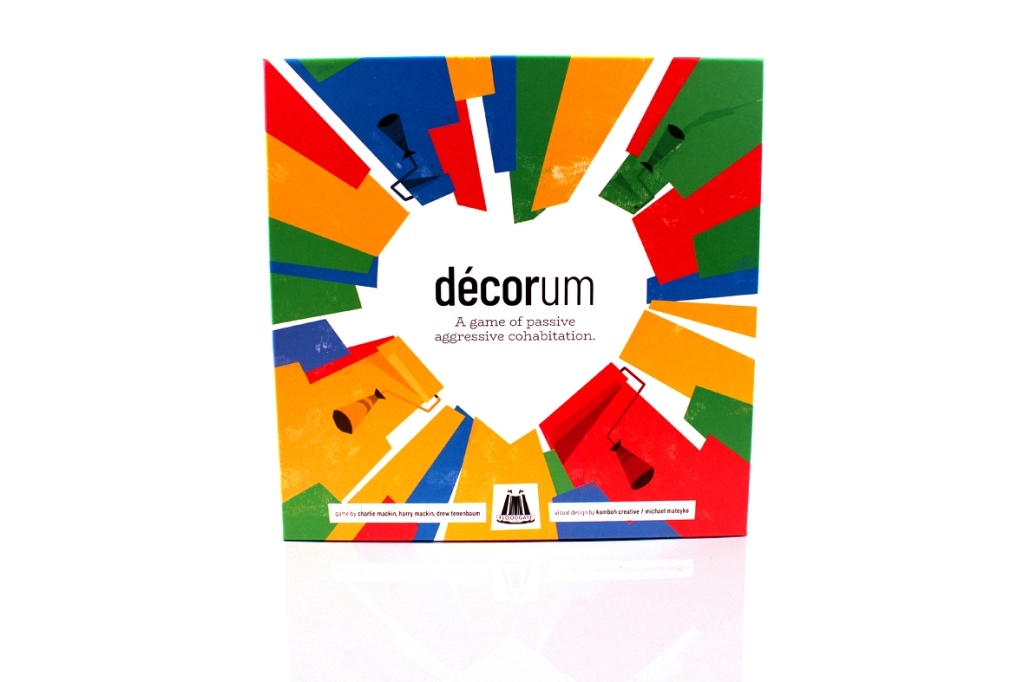
Base price: $45.
2 – 4 players. Scenarios differ between 2 and 3/4 players.
Play time: 30 – 45 minutes.
BGG | Board Game Atlas
Buy directly!
Logged plays: ~20
Full disclosure: A review copy of Décorum was provided by Floodgate Games.
Campaign games are notoriously, within my style, a little bit hard to review. There’s just so much to cover! How will I know that I got everything? What happens if I miss a few things here and there? This is also why I haven’t reviewed more highly-modular games that I love, like The Legend of Korra: Pro-Bending Arena and Spirit Island. So much going on in a box that it’s hard to feel like I’ve gotten a good ground for everything, even after a bunch of plays. For some reason, this problem didn’t come up quite as much with Décorum, Floodgate’s new cooperative campaign game. Maybe it’s the lack of legacy elements? Hard to say. Either way, let’s get into it!
In Décorum, you take on the role of some new roommates. A real odd couple, or trio, or tetrad. I never get to say tetrad enough. Just trying to smoothly work it into conversation. I think it’s working. Regardless. You’ve got some conditions that you’re positive will make the house more workable, for you at least. And indeed, at most. Your partner(s) have their own plans and desires, and it’s going to take some heart-to-heart conversations (or a house meeting or two) if you’re going to make everything work. Will you be able to turn your new house into a home? Or will you just end up with a house divided?
Contents
Setup
Since the game’s core loop seems more two-player focused, I’ll start with that and then cover 3p / 4p setup later on.
First up, set out the house board, on the two-player side:
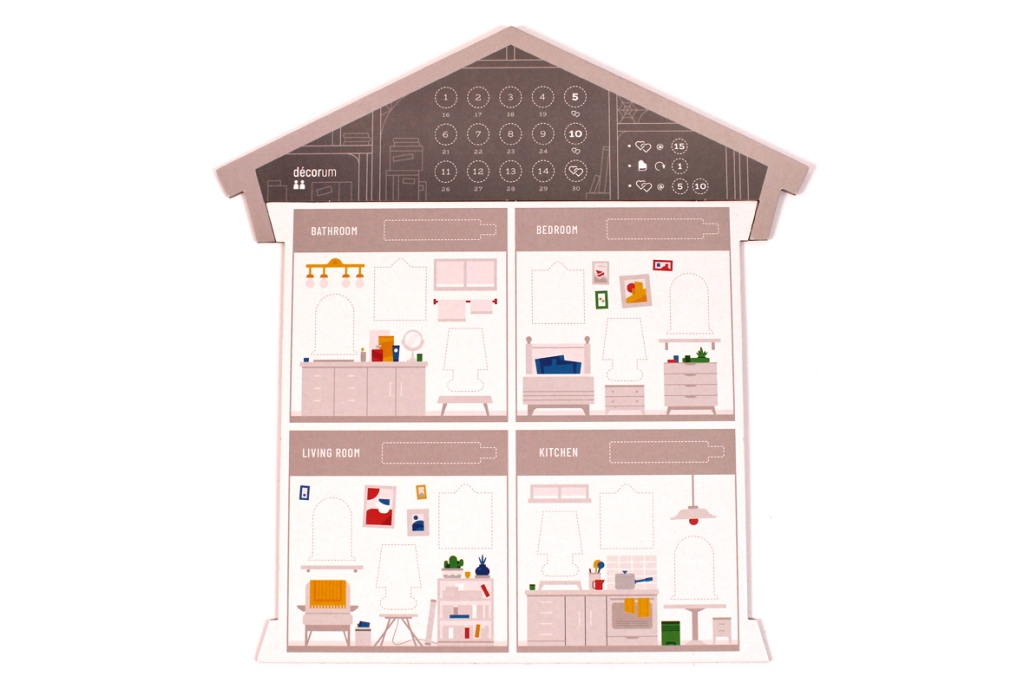
Place the Heart-to-Heart tokens (three of them, to be precise) nearby, and place the round tracker heart on the 1. Next, set up the item board:
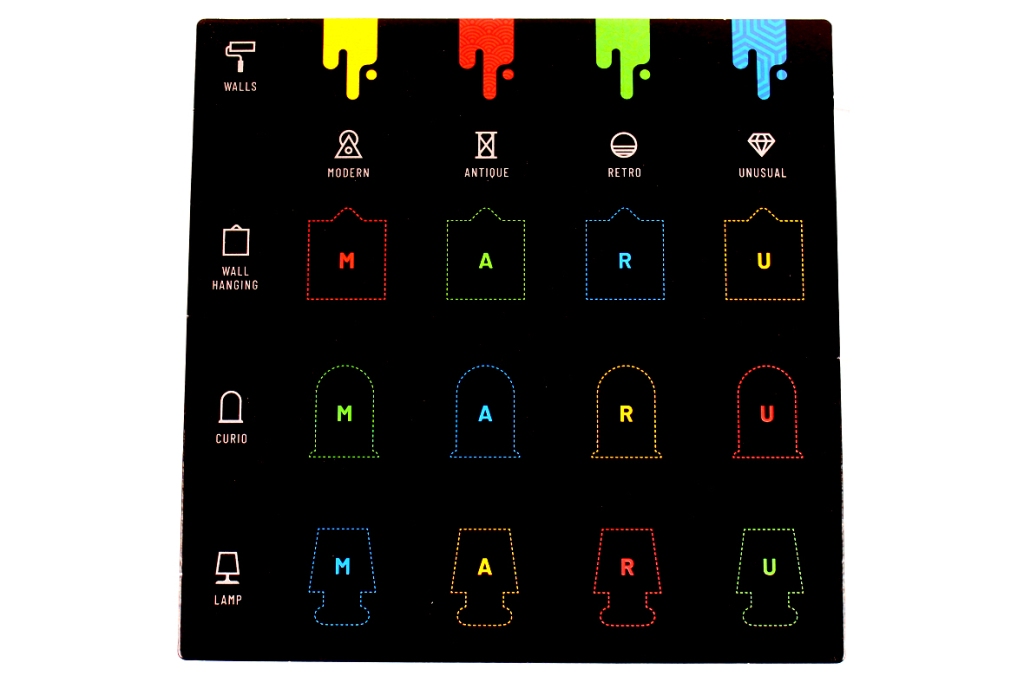
There are a lot of items, so each is going to go in a specific spot on the board. There are Wall Hangings, Curios, and Lamps, and each item type comes in a style: Antique, Modern, Retro, or Unusual. This provides for twelve different item/style combinations, with some room above for wall colors. Place the tokens on their corresponding locations.
I’m genuinely unsure what you do with these divider tabs.
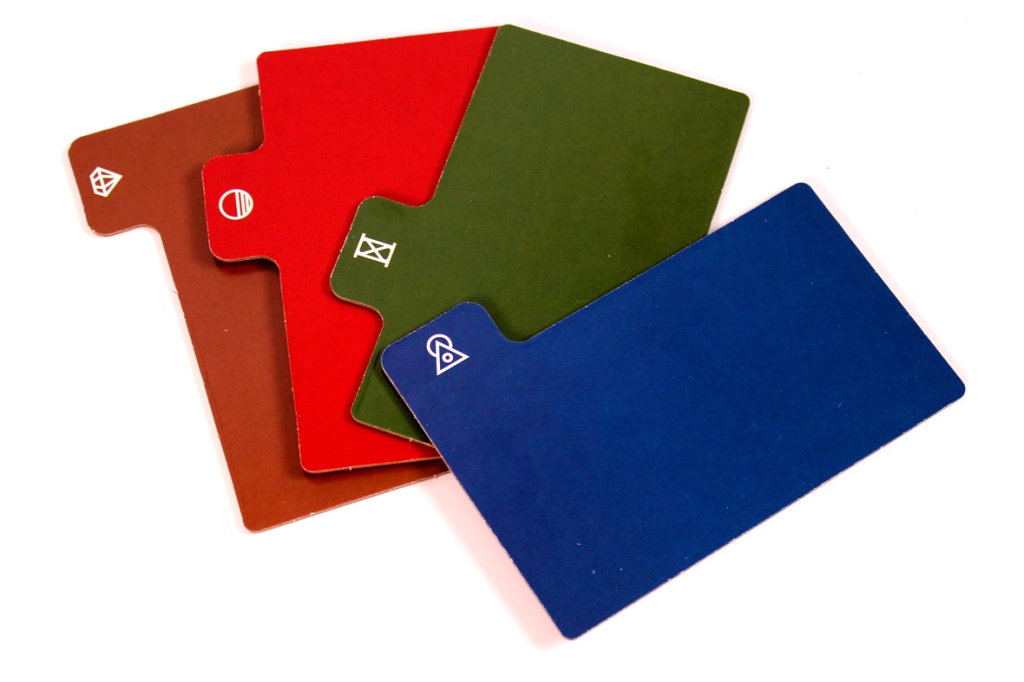
Once you’ve set up, take the first available numbered envelope for the two-player scenarios. There’s a card that will give you some narrative and one card for each player that will give you the relevant criteria (and establish which player is player one and which is player two). Don’t look at the player cards until you’ve dealt them out to both players (and each player should only look at their own card). Otherwise, set up the room according to the narrative card, and you should be ready to start!

For three and four players, the game is a bit different. There’s a different side of the board, and you should use all five of the Heart-to-Heart tokens (to represent House Meetings). Also, you’ll use the 3p / 4p scenarios, indicated by the player counts on the envelope. Give each player their large card and also, the three small cards of the same color included in the envelope. There are no small cards in a two-player game; this is exclusive to 3+. If playing with three players, set aside the fourth player’s large card. Instead, distribute each of the fourth player’s small cards (included in the envelope) to the indicated other players. Essentially, these will function as an extra condition for you during gameplay. More on that later.
Gameplay
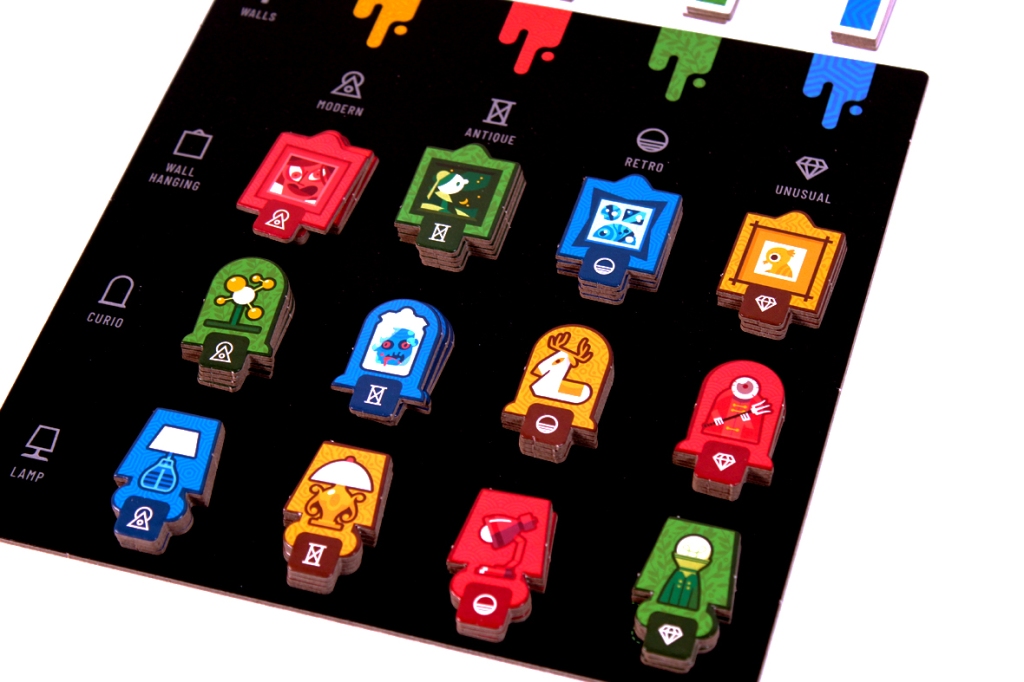
Your goal in Décorum is simple: compromise! Kind of. You see, there are a few non-negotiables that you refuse to budge on, but you can’t just tell someone what you need. So you’re going to decorate the house how you like, your partner(s) will do the same, and you all will just see how things turn out. Simple? Probably.
Each player starts the game with three to five constraints on their player card (also loosely called tasks or goals, depending on my mood). These must be completed for you to win. Your partner has an entirely distinct set of constraints that they need to fulfill, as well. If, at the end of a turn, all players are fulfilled, you win. So let’s talk through a turn.
Player Action
Each player can take exactly one action on their turn, of these five:
- Add an item: Take any item from the item board and add it to an empty slot of the same type. You cannot add an item to a slot that it does not match.
- Remove an item: You can remove any item from the House board, returning it to the item board.
- Style / Color Swap: If there’s already an item in some slot, you may swap it out for an item of the same type (curio for curio, for instance) but a different style or color.
- Paint a Wall: You may swap any room’s wall color for a different wall color. Rooms must always have a wall color, though; you can’t unpaint a room.
- Pass: If, on your turn, all of your constraints are met, you may pass instead of taking an action.
Notably, you cannot swap items between rooms or swap different types of items. You cannot, for instance, remove a lamp and add a curio in the same turn. Careful with that.
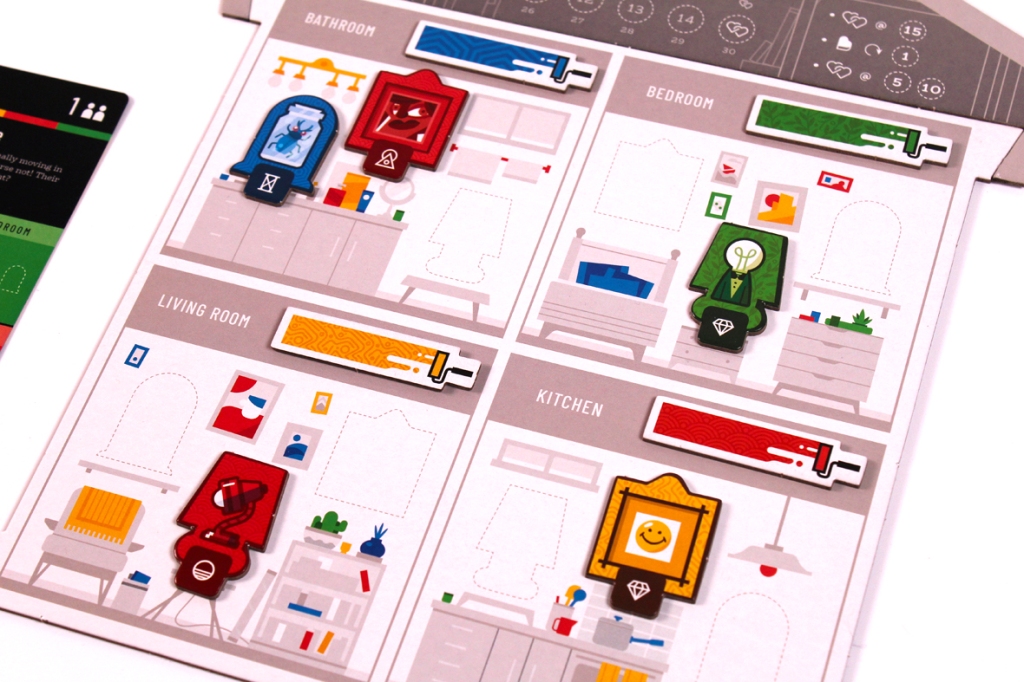
Fulfillment Check
This one’s pretty simple. If all of your constraints are met, you just say, “I’m fulfilled”. That’s all. Nothing else.
Comments
This part is fun. Every other player may now react to the player’s move. You may react positively, negatively, or neutrally, but you cannot reveal any information about your constraints. I usually go with “I loved that!”, “I hated that!”, “That makes me feel nothing!”, or something equivalent. Feel free to throw in references, puns, character work; whatever makes you feel like you’re getting your point across and mildly annoying your partner. It’s win-win.
End of Round
Normally, nothing happens at the end of a round. After Round 15 ends, however, players have their first Heart-to-Heart. During a Heart-to-Heart, each player reads one of their conditions aloud. You may change which condition you want to read aloud based on the condition the other player read, so decide between you which player is going to go first. Then, flip a Heart token face-down and move it to the other side of the House board. Move the Round Tracker back to Round 1 (representing Round 16). Now, players will have two more Heart-to-Hearts (after Rounds 20 and 25), and the game will end after Round 30 if any player isn’t fulfilled.
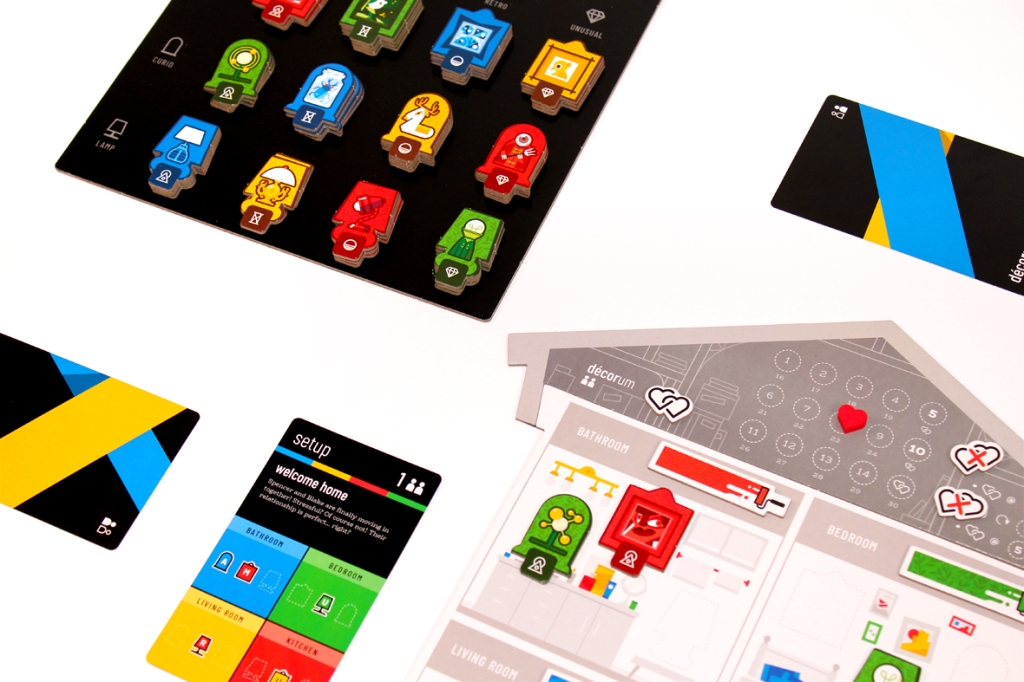
End of Game
As soon as a Fulfillment Check passes, the players win! If, at the end of 30 rounds, at least one player still isn’t fulfilled, the players lose. Either way, move on to Scoring.
To score, players earn 3 points for every fulfilled constraint. If all constraints were fulfilled, score 2 extra points for each remaining Heart token (from the Heart-to-Hearts).
Three- and Four-Player Changes
For more players, the game works basically the same, but with one important difference. Heart-to-Hearts are now called House Meetings, and they happen every five rounds (rather than every five rounds after Round 15). During a House Meeting, players first state how they feel about the house as a whole, in any order. Then, players each choose one of their small cards (listing one of their constraints) and give it to a player of their choice. These gifts do not have to be reciprocal or balanced; one player may receive cards from every other player, for instance. After that, players keep going as though a Heart-to-Heart just ended (flipping the token over). That’s the only major change!
Player Count Differences
I’d say start with two, on this one. Décorum seems to largely be built around the two-player campaign, and while I appreciate the addition of 3p / 4p mechanics, the four-player game is tough. The reason why, mostly comes down to communication. At two, the gap between your moves is really just one player’s turn. Generally, most players don’t immediately undo their partner’s move, so, the game progresses a bit (rather than just stalemating). At four, you have three times as many moves happening between each one of yours. While that means you can get more done, it also means that if you’re not paying pretty rapt attention, it’s very possible to lose the thread and have trouble picking out what each player’s individual requirements are. While the house meetings are a great way to spread around requirements (and are, frankly, pretty great), you have a much greater risk of what I’d call a “rotational symmetry” problem: essentially, multiple players have roughly-equivalent-yet-different versions of the house in their mind, and they end up split between those visions. At two, that doesn’t happen to quite the same degree. I think it would ease up, difficulty-wise, if everyone has played a game or two of Décorum, before trying a four-player game, but in lieu of that I would probably start with two players. More is fun (especially since, with three, you just distribute the fourth player’s requirements), but it would be excellent to have a practice game or something to get players warmed up, first.
Strategy
- Don’t just undo your partner’s turn, at least until late in the game. I find that if your partner does something you hate, let them know that you hate it, and then try to correct it either elsewhere or in another spot in the same room. Or, make a move that is a “because you did X, I must do Y” kind of move. Hopefully, your partner is keeping track of what you’re doing while they’re doing what they’re doing, so that they can figure out your constraints.
- Watch for patterns. If you see something like, every time you place a blue lamp, your partner changes the room’s color to blue, you might start to suspect that those two events are correlated. Don’t confuse correlation and causation, but the correlation is worth investigating. It might be that the wall color must match the lamp color; it might be that the room can only be cool or warm colors; it might be that every room in the house must be a different wall color and they have other constraints that make this room easier to make blue. But there’s often a method to your partner’s movements, so observe them and keep track as best you can.
- It’s sometimes easier to move in response to another player’s move, rather than continually doing your own thing. I generally pick a constraint and work towards it to start, and then I try and pivot as my partner and I become at odds with each other. If my partner does something I don’t like, I will usually express my displeasure via a different action that’s related to that, either swapping something else or rebalancing the house as per my constraints. If I ignore my partner’s action, they get no feedback on it, whereas if I incorporate a response to their action into my action, I advance my own constraint and communicate information to them. It’s doubly helpful.
- Get a sense for the kinds of tasks that are available. There are a lot of different types of tasks; it’s worth reading the back of the rulebook to get a sense of at least the keywords that will pop up. If you’re not sure that something can even be a constraint, it’s going to be very difficult to fulfill it in any useful way, right?
- Sometimes it’s best to pass once you’re fulfilled; other times, you might want to try and work towards your partner’s goals, if you can come up with them. If you have nothing else to do, then pass, but if you think you know what your partner wants, try to help them get there while keeping yourself fulfilled. If you mess yourself up, that doesn’t really help either of you, that much, unless you’re trying to communicate.
- Similarly, try to test for your partner’s goals. There’s always a solution where all needs are met, so do what you can to find it. The solution must exist, so if you’re hitting an impasse, there’s something at least one of you doesn’t understand. Testing for each other’s constraints can be a useful way to suss out the shape of the puzzle, even if you don’t have all of the pieces, but keep in mind that the solution definitely exists, even if you can’t get to it in your remaining turns.
- I wouldn’t necessarily assume that your starting configurations are very close to the final result. Your starting configurations usually not close to the solution. This isn’t to say burn everything, but also don’t get too comfortable with your starting rooms; there are often a lot of things that need changed before they end up being finalized.
Pros, Mehs, and Cons
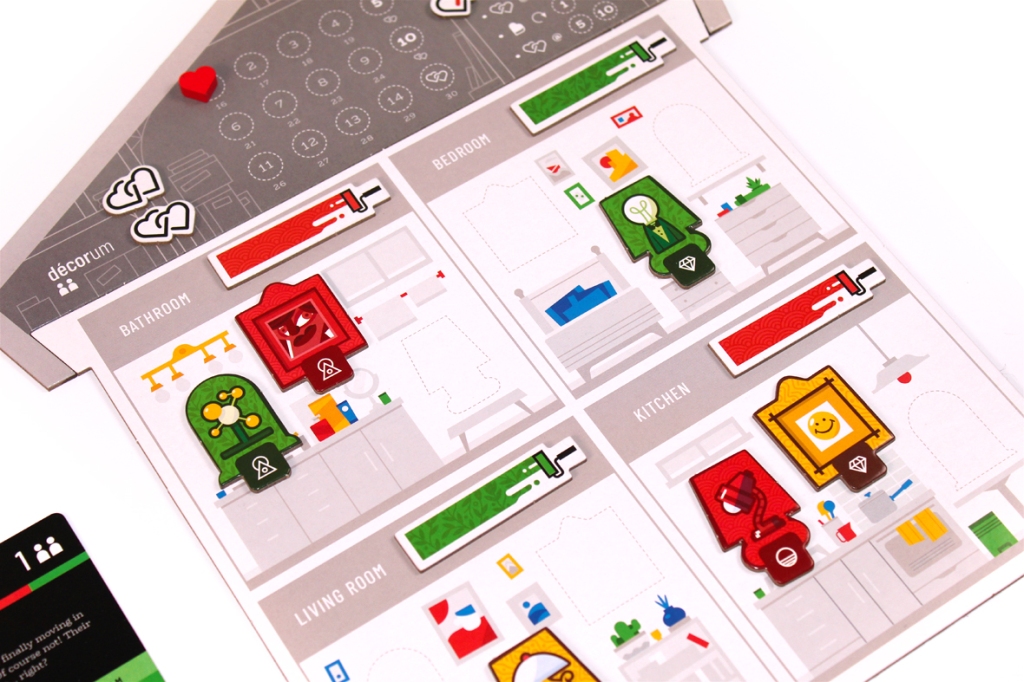
Pros
- I think there’s a point where the game is going to get too difficult for most players, and that’s actually a good thing? I’m pretty personally opposed to difficulty in games, or at least one pathway through games that has no toggle to make the game easier or harder, but I think, assuming the mobile app can generate its own scenarios with a high degree of fidelity, the actual progression through the core game is a great way for you and a partner to figure out your preferred level of challenge. Where does the game become “too hard”? I’d recommend going through all 20 to find that point and then using that to play scenarios around that zone so that you’re challenged without being bored, moving forward. I like that the scenarios (tend to) get gradually more difficult so that I can figure out my ideal zone. For me, it’s probably somewhere around #16 or #18.
- The game’s aesthetic is very fun. I like it a lot! It’s bright, clean, and colorful, and a lot of the items (especially the Unusual ones) are fun shapes and colors. It’s interesting, since I kind of would have expected this game to be more aesthetically similar to IKEA-style things, but it’s just a blank slate with some colors that you can work in. Some of those wall hangings are definitely odd, though.
- I do love a deduction game. You’re basically playing “hot or cold” with other players as you try to place your own stuff and trying to figure out a configuration that satisfies all constraints. Feels like a max sat problem, but, uh, we won’t get into that in this review. Plus it’s not quite that, but if you want to read more about it, have fun. I really enjoy trying to figure out other players’ constraints and the little “click” in your brain when you’ve got it is very satisfying.
- You can be very snooty about other people’s decor choices, if you want. Feel free; the game encourages it. Just make sure you’re not accidentally revealing your constraints!
- Once you get used to the flow of the game, the game can play pretty quickly. Maybe a bit too quickly, given my propensity to lose track of what round it is, but we were definitely able to get through some of the games pretty fast once we got used to the interaction and communication flow of the game. It made for a great before-dinner play, honestly, though we tend to eat dinner pretty late.
- I really like how the information-sharing works in three- and four-player games. I had wondered how it would work, given that you share information verbally in a two-player game, but including cards with individual constraints that you pass to players of your choice is genius, since you start building up these complex interconnected knowledge webs. It’s a really interesting way to share information, and I’d love to see it in more games. You essentially make constraint cohorts where everyone in that cohort knows one of the twelve to twenty constraints in each game, trying to layer out something collectively.
- There are fun mini-narratives in each round, and I really like the way that they grow over the course of the two-player scenarios. They grow and actually progress, which I appreciated, and I felt like they were fun ways to contextualize the game against something more than just an abstract deduction game. Plus, they were a little goofy, which was fun. Microfiction is a perfectly fine thing to include in your games, and Décorum felt more grounded, as a result.
- I’m also very excited about the mobile app having more scenarios, since we kind of blew through the two-player game in a few days. Cryptid has a similar setup, with some in-box scenarios and a mobile app at the ready to generate even more (with solutions, hints, and help, which I appreciate). The one hazard of writing this before the game formally releases is that, sadly,
- The later scenarios introduce some fun elements. No spoilers! Just something to look forward to, right?
Mehs
- Humorously, since the rounds move so quickly, I often forget to update the round tracker. This doesn’t really help us that much (in some of our worse games, no number of additional rounds would have gotten us out of that hole), but it’s an interesting consequence of games with quick and straightforward turns. Since they move so fast, you can get distracted in the thinking and the planning, not the updating.
- I really didn’t care about scoring at all. I think it’s mostly there to appeal to the “gotta get the high score” folks, same as the stars in an EXIT game, but I honestly found it kind of boring to even calculate, from time to time. Then again, I’m not really a high score person, either, so this scans.
- It might have been wise to make the wall colors patterned, rather than just relying on color as the sole indicator on cards. I generally try to advise folks away from color-as-primary-indicator, and while the colors are pretty bold and distinct, I wonder if a pattern would help to disambiguate the colors for folks that can’t distinguish? Not sure.
- While mechanically, I understand it, the inability to move one object to an empty slot in another room feels frustrating, especially in later scenarios. It’s not a big deal; just a common mistake / pain point for some players. As they learn the game, they often ask if they can move a lamp to another room, and that’s not a valid action, which they bristle against. It’s an interesting thing to observe, but not much of a problem with the game.
- I hope that the mobile app includes something like a reference for some of the constraints, just because if players don’t understand the constraints, the game falls apart very quickly. Mistakes are a pretty singular way to bring the game down. If I think I’m fulfilled and I’m not, well, the game’s busted. If I conflate color and style, the game’s busted. There are a lot of possible mistakes a player can make (which is, in part, why the game tries to increase gradually in complexity), but even having a way to get an example for a given constraint would be hugely helpful for letting players figure out what they’re supposed to do.
Cons
- As the constraints get increasingly complicated, the wording of them doesn’t necessarily help make things easier for players. The game tries, as it progresses, to do something that I’m guilty of as well, which is just overloading sentences. They’ll stuff two or three constraints into one so that they fit in the “three to five constraint” requirement, which often makes the constraint extremely difficult for new players to parse. As I mentioned above, a player who doesn’t understand the constraint they’ve been given is an existential threat to the scenario, so it may have been worth separating them out and just making them worth fewer points to keep the scoring consistent. Some of them are dense to the point of feeling like they’re multiple bullet points just shoved together for convenience rather than practicality.
- I’m surprised there’s no answer key for the scenarios. I assume this is partially because there’s likely more than one correct answer for several of them, but just indicating “This is one possible correct answer; others exist.” would be fine. For the harder scenarios (especially as more complexity gets added), it’s sometimes nice to be able to check our work and make sure that we understood the requirements correctly. In one particular case, we were just so vexed that it would have been nice to see what answer there was.
Overall: 8.75 / 10
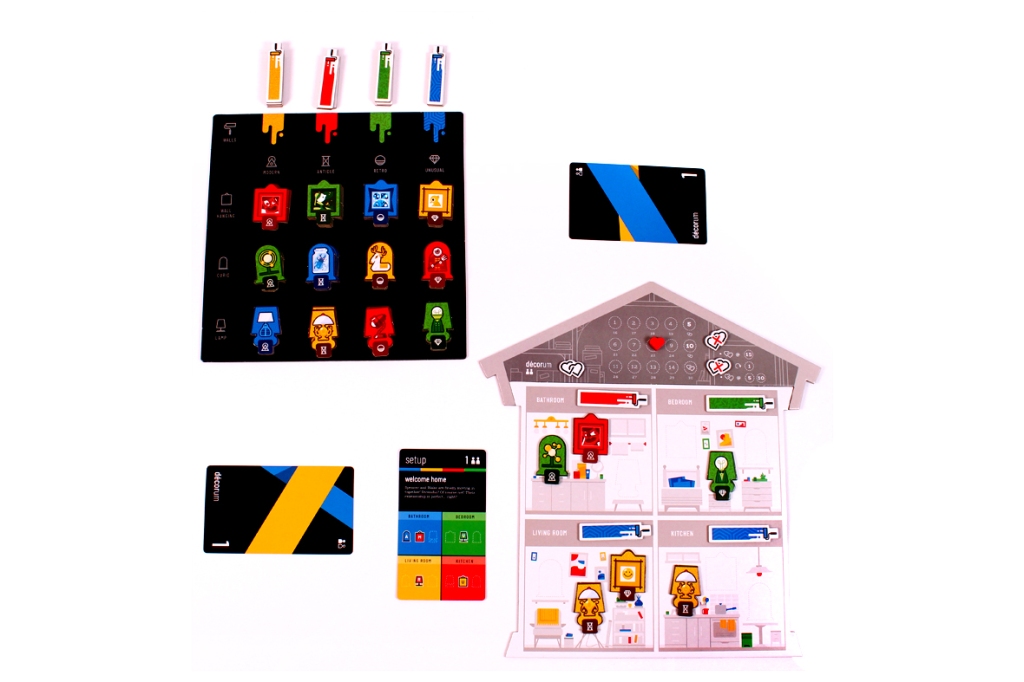
Overall, I think that Décorum is quite a blast. Naturally, there are some things that are a bit rockier about it, but I think on the whole the strengths of the game outshine its weaknesses and make for an experience that’s entertaining, challenging, and compelling. The particular frustration points for me are largely around how the game handles itself. For a game where any player error can force an invalid state that cannot be recovered (since knowing any player’s decor constraints gives away the game), there seems to be a surprising lack of scaffolding around teaching players what their constraints mean. This means that, often, players are left to divine sometimes-confusing constraints, and a mistake there brings the game down (and leaves the player feeling terrible). This happened twice to us during our sprint through the game’s robust twenty two-player scenarios, and I would have liked a bit more guardrails around that, since that’s a place the game can fall apart. That said, I do think that having scenarios that can be generated via the mobile app (once it’s available) will make the impact of this problem less severe. You goof something, you reset; it’s fine. The same thing can happen in Cryptid, and they have a functionally-infinite number of scenarios to compensate, so I’m not mad about it. There were a couple scenarios that stumped us, however, and having an answer key would have gone a long way toward helping us figure out what we did wrong before pressing forward. Would love to see that in the mobile app. This paragraph seems harsh for the score I’m giving the game, so let me expand on the positives a bit more to compensate. Décorum is a delightful and novel spin on the cooperative deduction space, and the various scenarios are fun little narrative blurbs where we actually found ourselves invested in the characters and their own little stories as they went further and further along. There’s a reason we played all twenty two-player scenarios in, like, a week, after all; we genuinely enjoyed it, despite our frustrations at some of the criteria. We also got good at the game, which felt incredible. We were moving quickly, crushing scenarios, and unlocking additional rules and constraints and twists that kept us entertained for a while. Honestly, I’m hoping to play more once I can do so, since I’m out of two-player scenarios at the moment. We’ll see. I think Décorum will appeal to the puzzlers, the decorators, and the compromise-prone, eager to sort a problem and move onto the next one. Maybe even play it with your roommates and see if it helps you communicate about other furniture-related issues? Who can say. I thought Décorum was quite a solid game, and if you’re a fan of decorating, you enjoy deduction, or you want to wrap your head around a challenging puzzle, I’d definitely recommend checking it out!
If you enjoyed this review and would like to support What’s Eric Playing? in the future, please check out my Patreon. Thanks for reading!

